Blog
New Features in Joomla! 2.5
Joomla 2.5, due out in January 2012, will have a host of new features including new search functionality, multi-database support, and update notification. The following article describes these features. Many people in the community have contributed to making these features possible, some of whom are listed here. Moving from 1.7 to 2.5 can be done with the one-click upgrade within Joomla and most extensions that run on 1.7 should also run on 2.5.
New Search Function

Based on Finder, which was developed by jXtended, Joomla 2.5 has added an exciting new natural language search function. This feature incorporated auto-completion and stemming. Stemming is the ability for the search to use the root of the word you entered to locate matches. While there is still work to be done, this search is also much better at searching in languages other than English.
This new search is faster and more versatile that the standard search. The data is indexed to get this flexibility and speed. New plugins are required to use this search. Joomla ships with the new core extension plugins, but other extension developers will need to create their own plugins to work with this new search. By default, the standard search is active and this new search is disabled. You can enable the plugin and index your files when the extensions you want to search have the new plugins.
Of interest to: Users, site creators, developers
Credit to: Rob Schley, Michael Babker, Elin Waring, Chris Davenport, Omar Ramos, Viet Hoang Vu, Jean Marie Simonet, Rouven Weßling, Louis Landry, Gabriele Pongelli
Ability to Support Other Databases
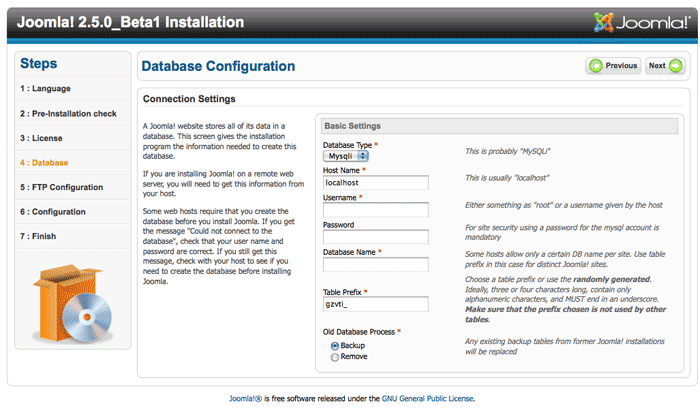
Joomla has traditionally run on the MySQL database. If your company has a different type of SQL database, such as MS SQL, then you'd have to make changes to the Joomla software to make it work, which makes updating difficult. Joomla has been rewritten so that different drivers can be written for different versions of SQL databases. Current drivers exist for the MySQL and MS SQL databases, with PostgreSQL, Oracle, SQLite and PDO drivers close to being ready.
Of interest to: Site creators, developers
Credit to: Sudhi Seshachala and the team at Hooduku (Microsoft databases), Gabriele Pongelli (Postgres), and Omar Ramos (Oracle, SQLite and PDO) and Elin Waring
Joomla Update Notification

The number one request from ideas.joomla.org was for Joomla to tell the site administrator when Joomla needs to be updated. Site administrators will now be able to see as soon as they log in if Joomla is out of date. They can then click the button and be taken to the one-click update to Joomla. A second icon does the same thing for any non-core components that are set up for the one-click updating by their developers.
Of interest to: Site administrators
Credit to: Nicholas Dionysopoulos
Database Version Fix Button
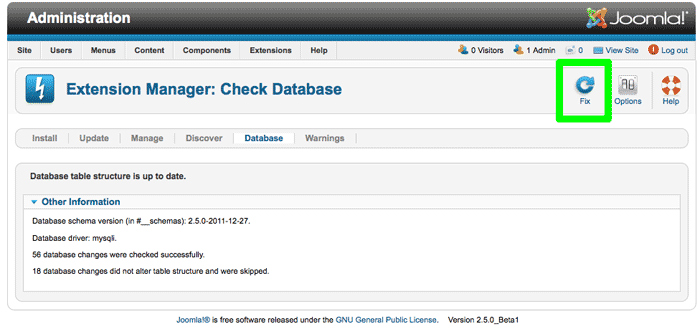
A new feature was added that will check to see that your database is up-to-date with any database schema changes added during upgrades. If they are out of date, you can press the Fix button to apply the needed changes. This is important for those people who are used to updating releases the 1.5 way by FTPing up the release files. Since FTPing cannot apply database changes, those people would have to apply the database changes manually. Not everyone has the access or the knowledge to make those changes. With this improvement, you just need to go to Extensions/Installation/Database and hit the Fix button. If you use the Update feature in Extensions/Installation/Update or install the upgrade in Extensions/Installation, you won't need this feature.
Of interest to: Site Administrators who update by copying files
Credit to: Mark Dexter
CAPTCHA in Core
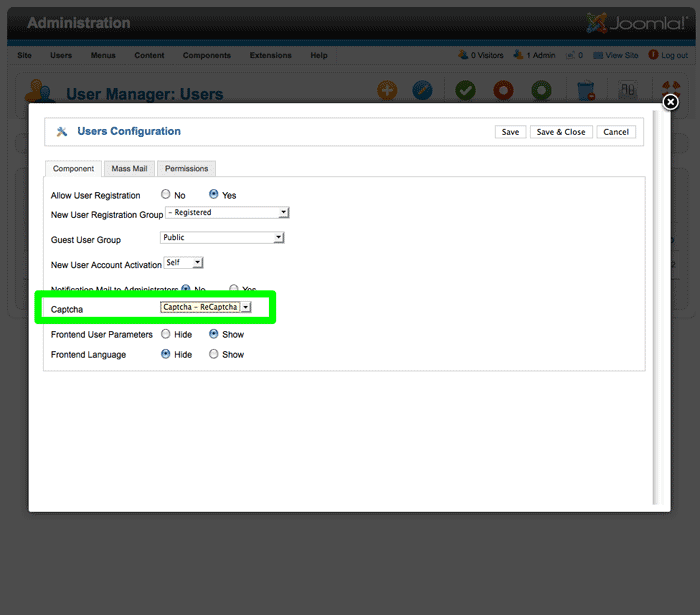
CAPTCHA uses scrambled text to prevent robotic spammers from submitting forms. Joomla 2.5 gains an API that lets you use CAPTCHAs in your forms. The core comes with a a plug-in that gives you the ability to use reCAPTCHA, the most accessible of the CAPTCHA services. Once you sign up for free with reCAPTCHA and enter your keys, you can enable CAPTCHA on new user registrations. It could also be used by other extensions needing CAPTCHA. CAPTCHA has been available in non-core extensions, but this enables the feature in core.
Other plug-ins can be created by the the developer community and will work with all forms without modifying them.
Of interest to: Site Administrators, site creators
Credit to: Jonnathan S. Lima, Rouven Weßling
Linking New Menus with a Module
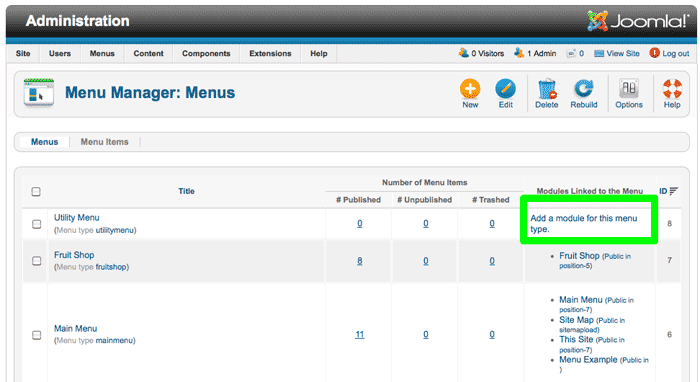
Modules were automatically created for each new menu type in Joomla 1.5. However, not everyone used the core menu module, but used instead ones from custom templates or non-core modules. For that reason, menus did not automatically create a module in 1.6/1.7. This change confused people and created extra work. In Joomla 2.5, if there is no module associated with the menu, there is a link showing in the Menu Manager that you can click that will take you directly into a new module that you can create. You then have the choice of saving this standard menu module or cancelling out and using a different menu module.
Of interest to: Site Administrators, site creators, content creators
Credit to: Andrew Eddie, Jacques Rentzke
Use the Images and URL Fields to Create Simple Standardized Layouts

In 2.5 you can choose to use the existing image and URL fields in the articles to set up a simple standardized layout for blogs, news reports, etc. These are fields that existed in the database but were never used. After you activate the feature in the Article Options Editing Layouts, you will be able to specify an image for the introduction and an image for the full article, as well as 3 links. This means that your content creators won't have to fuss with an image in the text (you can even disable the image button in the editor) and your article format will be cleaner and more consistent. You can use css, layout over rides and alternative layouts to customize your pages even further. This feature also allows easy customization of the back end article editor to limit content creator and content editor options, for example removing the ability to change the images or publishing options.
Of interest to: Site administrators, site creators, content creators for sites that need a simple, consistent content layouts but not a full featured CCK.
Credit to: Elin Waring
Choose whether Administrator to Get Email When New Users Register
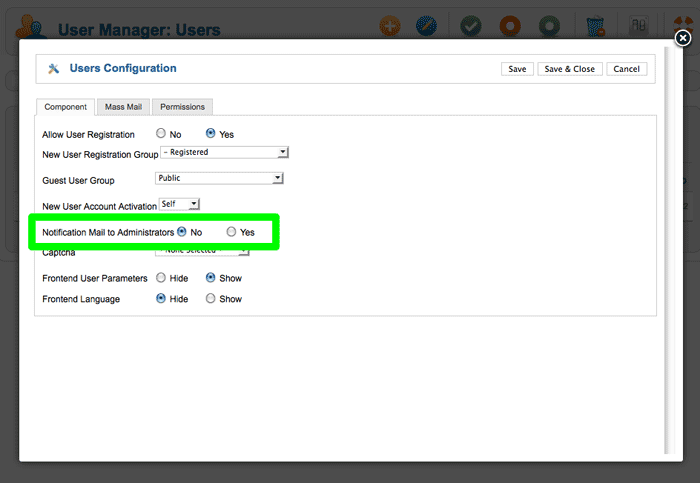
You can now choose whether the administrator get a new message when a user creates an account.
Of interest to: Site administrators
Credit to: Kenny Wickstrom
Menu Item Note

In 1.7 you had the ability to add a note to modules to remind you what the module was for. This feature adds that ability to menu items. You can use it, for example, to identify the menu item, clarify how it is used, or why it was set up the way it was.
Of interest to: Site administrators, site creators, content creators
Credit to: Marcell van Geest
Custom Text Filters

The Text filtering done automatically by Joomla when a user enters text has moved from its hiding place in the Articles Options to Global Configuration. This is appropriate since it covers all the components, not just articles.
Even better, you are now able to create your own custom blacklists. Blacklists are easier to manage than a whitelist because blacklists contain only the forbidden tags and attributes. In 1.7, you either used the default blacklist or you resorted a whitelist where you had to type in all the possible tags and attributes that were allowed.
You can also use User Groups to give certain people permission to use a tag/attribute on the blacklist. Just create a User Group for, say, the people who can use iframe. In the Text Filter specify that User Group as whitelisted with iframe in the tag list. If you want to let someone use iframes, just add them to that new User Group.
In addition to the filtering done by Joomla (which covers all input forms), your chosen editor may have its own filtering process as well. For something to be allowed, it must get past both the Joomla text filtering, if any, and the editor filtering, if any.
Of interest to: Site Administrators, site creators, content creators
Credit to: Tore B. Krudtaa, Denise McLaurin
Greater Flexibility Filtering by Category in Article Manager

In 1.7 when looking at articles you could filter by category. However, you didn't have a way of selecting a category and getting all the articles that are in that category and its subcategories. In 2.5, selecting a category in the articles manager will include its subcategories, down to the depth you select. If you only want the single category, you can select a level of 1.
Of interest to: Site Administrators, site creators, content creators
Credit to: Ofer Cohen
Manager for Language Overrides
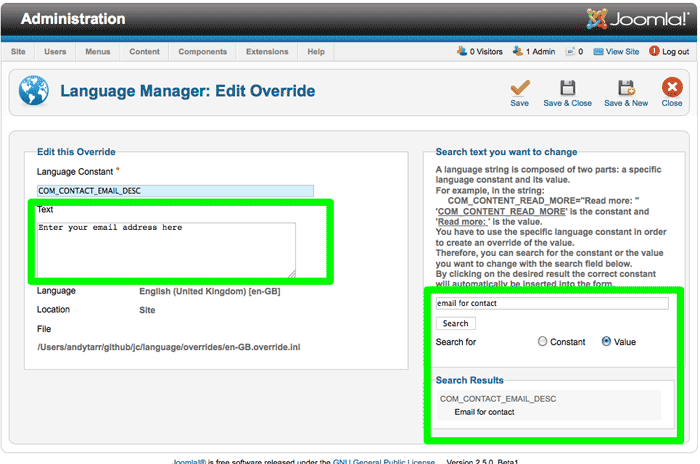
In 1.7 you could add overrides to language files to change the text. So if you wanted to change a label, message, or tooltip, you could put the language key in a text file in the right spot with the right name with the wording you wanted, once you figured out what the language key was. This was an improvement from 1.5 where you had to hack core.
With this new feature you can make these changes in the familiar backend of Joomla instead of putting on a programmer's hat. You search for the text that you see and get a list of language keys and text for you to select. You can then change what you want and save it. Want to add your Company's name to the email that goes out with the Forgot Your Password email? This is where you would do it.
Of interest to: Site creators
Credit to: Patrick Alt
User Notes

Now you can attach notes to users as well as assign dates to the users. These manual dates can be used for whatever you want, whether it's a date for reviewing the user, the last date you reviewed a user or for something entirely different. You can change the label for the date using the Language Overrides. You can have multiple notes per user and the notes can be in different categories.
Of interest to: Site administrators
Credit to: Andrew Eddie
Flexible Newsfeed Order
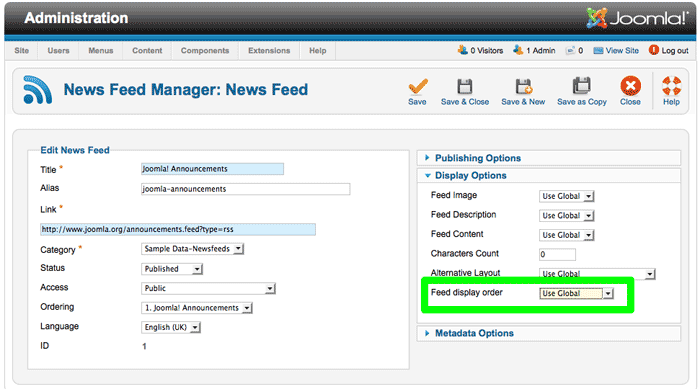
This feature makes it possible to reverse the order of the feed items. You can choose to display either the most recent first or the oldest first.
Of interest to: Site creators, content creators
Credit to: Mathieu Cattin
Image Option for the Offline Page
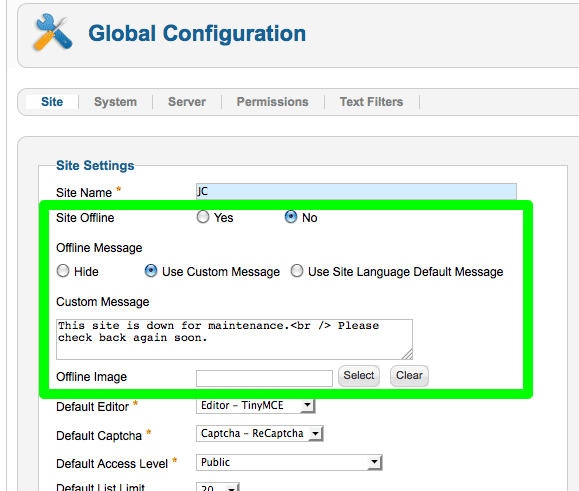
Joomla has always displayed a big Joomla logo when you put a site offline. This leads to confusion on whose site it is. In order to fix it, you had to provide a custom file in your template. With this feature, no image is displayed by default and you can upload/select any image you want to be displayed went your system is offline.
Of interest to: Site Administrators, site creators
Credit to: Jean-Marie Simonet
Option to Have a Site Come Up Offline After Installation
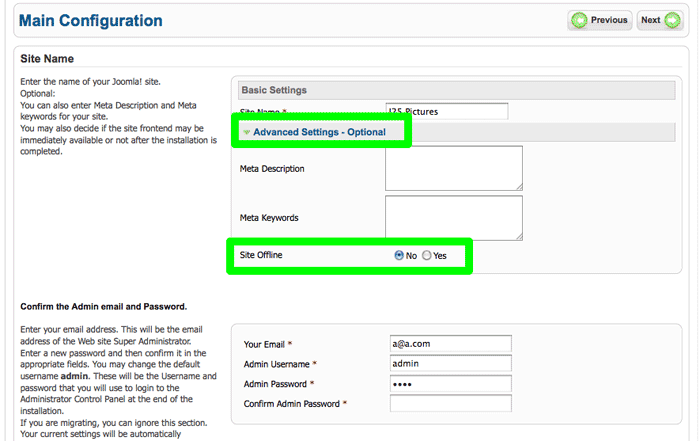
Before, when you installed Joomla it was automatically online as soon as it was installed. With this feature you have the option of having it come up offline so no unauthorized people can see it before you want them to.
Of interest to: Site creators
Credit to: fade2grey
Better Performance in Menu Item Edit page

The extensive options in "Select a Menu Item Type" are not loaded unless you need them.
Of interest to: Site administrators, site creators, content creators
Credit to: Dennis Hermatski
Status Display in Backend Enhanced

The footprint of the status displays has been reduced to prevent overcrowding (in English).
Of interest to: Anyone in the Joomla administrator
Credit to: Kyle Ledbetter
Filter the Frontend Who's Online by User Group
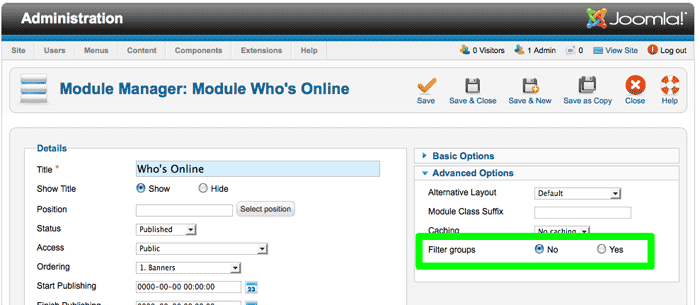
You can, optionally, limit the display of online users on your website to those in the same user groups as the user.
Of interest to: Site administrators, site creators
Credit to: Christophe Demko
Check for Native ZIP Support During the Installation

This feature adds a check during install to let you know if you have native ZIP enabled on your host. Native ZIP is recommended because it is much faster than using PHP to unzip. The slower speed of using PHP unzip could result in timeouts when you install large extensions or updates.
Of interest to: Site creators
Credit to: Rouven Weßling
Syndicate Text Label More Flexible

In 1.7 you could specify the text to display next to the syndicate icon. In 2.5 you can also choose not to display text or to use the default language pack text value.
Of interest to: Languages, Site creators
Credit to: Jean-Marie Simonet
Alternate meta tags for multi-lingual sites
This feature adds the ability for search engines to see the meta tags and links for corresponding menu pages in other languages in the associated menu items.
Of interest to: Languages, SEO
Credit to: Dennis Hermatski, Jean-Marie Simonet
Menu Items for different languages can have same alias in Multi-lingual
(Available shortly) With this new feature you will be able to have the same alias for menu items in different languages. You are able to get these URLs:
- /en/news.html
- /fr/news.html
Of interest to: Languages, SEO
Credit to: Dennis Hermatski
Improving SEO: New system plugin: languagecode
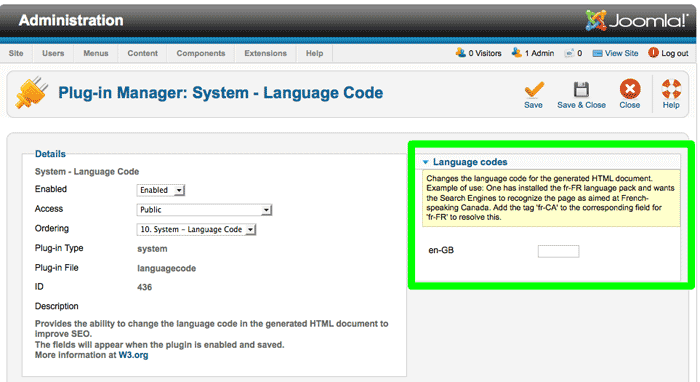
This feature allows search engines to see the language and country code they expect in cases where the Joomla language pack uses a different code.
Of interest to: Languages, SEO
Credit to: Jean-Marie Simonet
Debug Plugin Gets Formatting
When developers turn on the debug function, Joomla spits out various and, sometimes voluminous, amounts of unformatted data. This feature formats the different groups of data into sliders and color highlights the database queries. This works in both the frontend and the backend.
Of interest to: Developers
Credit to: Nikolai Plath
A True Autoloader for the CMS
With the Joomla Platform as a separate entity, the CMS needed a place to put files/classes that are universal to the CMS but not a part of the platform. With this autoloader, developers don't need to worry whether the class they need is in the platform files (libraries/joomla) or in the cms files (libraries/cms).
Of interest to: Developers
Credit to: Rouven Weßling

Schedule a
Free Consultation
Sometimes a relationship needs a little nudge to help it grow.
Tell us a few things about yourself and we will show you a lot more about us.


